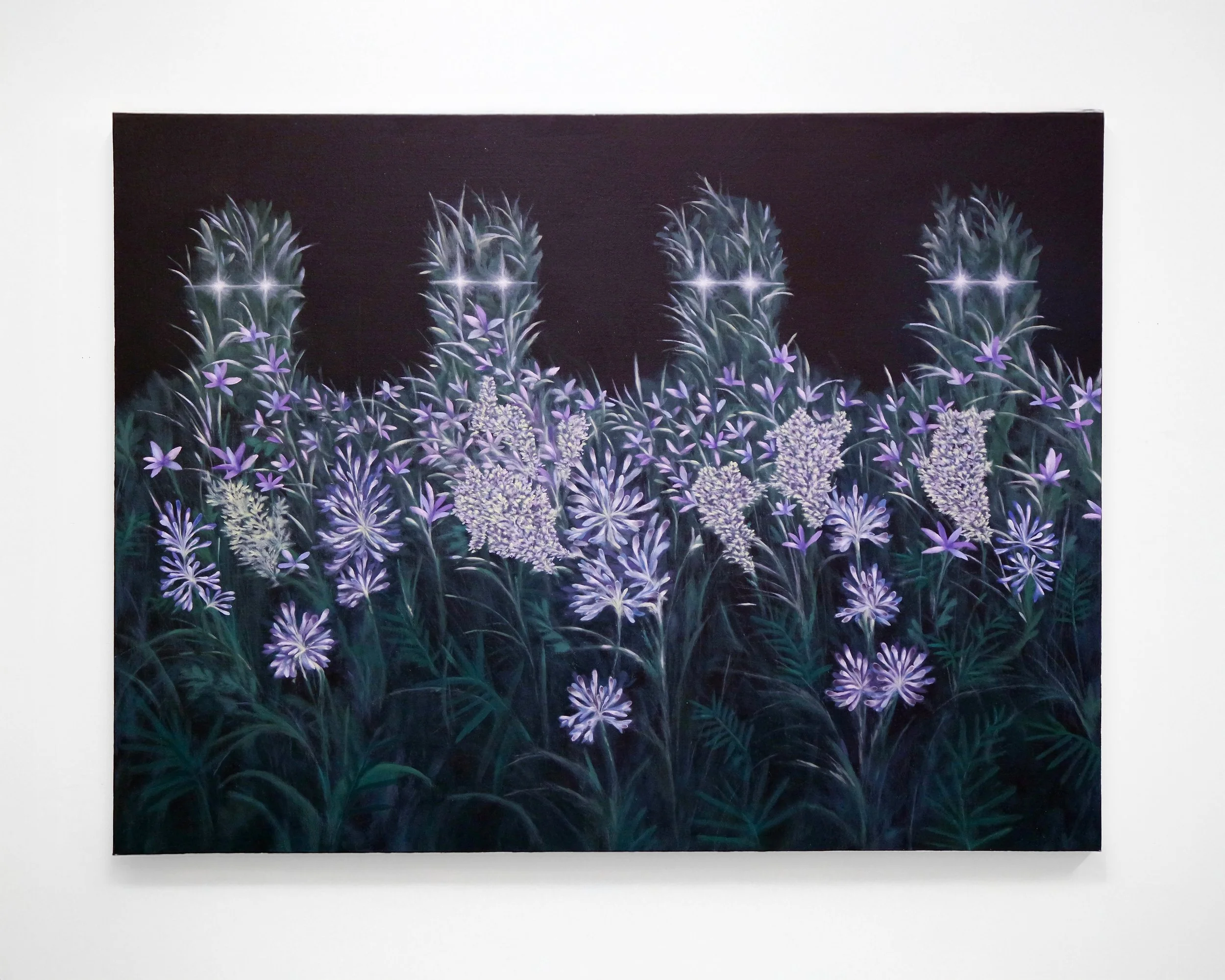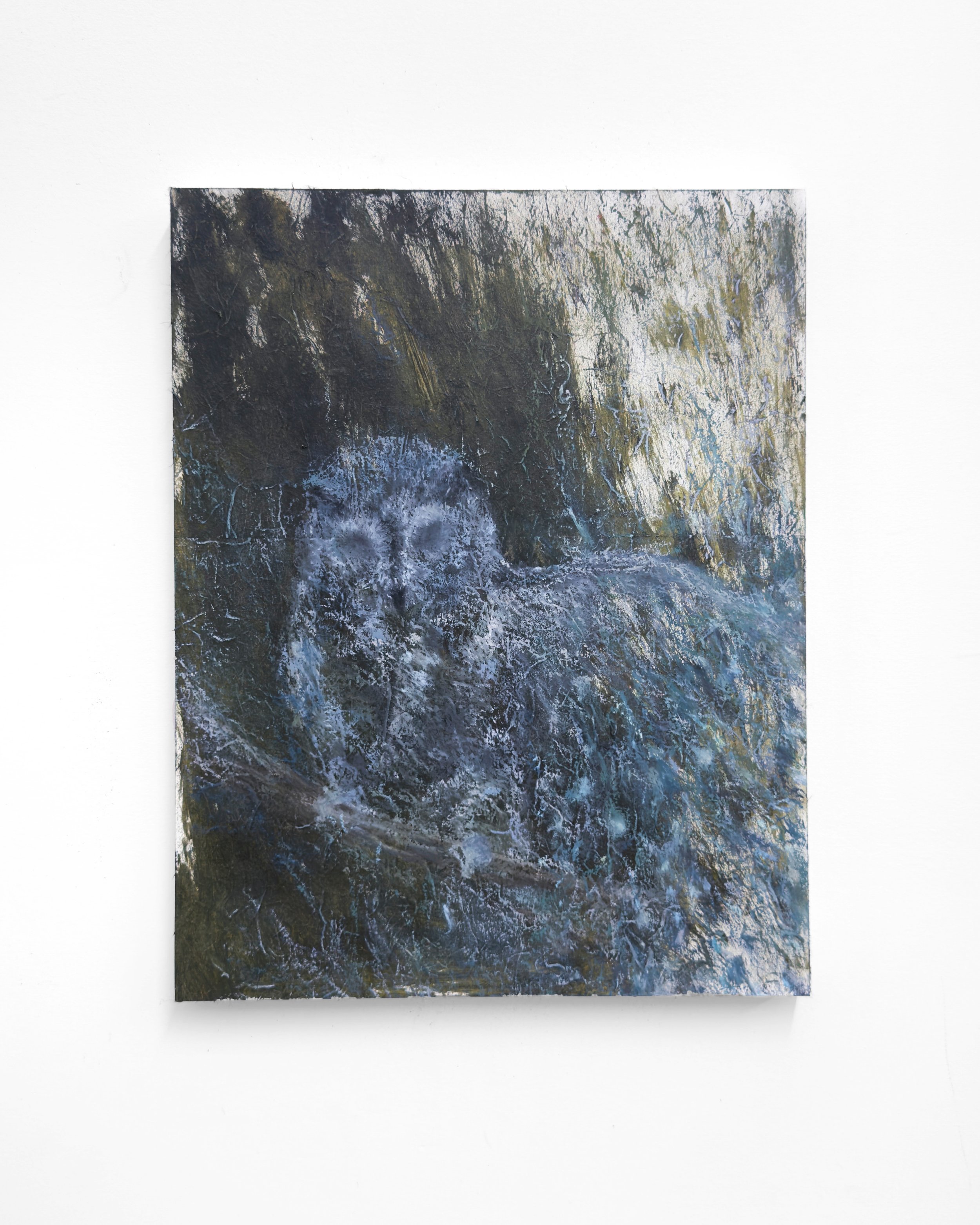10 Questions with Kimin Kim
Kimin Kim is a Korean-born painter currently living in Brooklyn, New York. His practice centres around the intersection of botanical symbolism, historical memory, and the ritualized navigation of grief. By deconstructing its colonial origins as a racialized stereotype and its development into a symbol of Korean ethnonational myth, he engages flora as both symbolic vessels and ritualized objects, drawing on their presence in Korean shamanic ceremonies, funerary traditions, and ancient tombs where petals accompanied the dead. His first solo show, Supulneol (Forestwaves), opened at Nua Gallery in Seoul in 2023, followed by No Leaf Will Be Shaken at Space 776 in New York in 2024. He is currently participating in multiple group exhibitions across New York.
Kimin Kim - Portrait
ARTIST STATEMENT
Kimin Kim’s practice echoes around the intersection of botanical symbolism, historical memory, and the ritualized navigation of grief. He investigates the multi-layered role of flora—as vessels of cultural memory and as metaphors for mourning—while engaging with the complexities of Han. This Korean ethos is a transmissible social construct that embodies the grief of the historical memory of past collective trauma, manifesting its significance as a lived experience shaped by history, power, and resilience. By deconstructing its colonial origins as a racialized stereotype and its development into a symbol of Korean ethnonational myth, he situates Han as a site of transformation.
Within this framework, flowers function as internal mediators—not only between the material and immaterial but also as an intersection of the postcolonial, the individual, and the collective. By layering painting and drawing mediums, Kimin dissolves the formal boundaries of representation and abstraction to investigate the interplay between individual trauma and collective histories.
Rooted in the literary metaphoric techniques found in 20th-century Korean poetic anthologies, Kimin associates painting with an intuitive action of longing for relief. He converts mark-making into a ritualized exploration of grief, renewal, and the emotional resonance of cultural memory by engaging flora as both symbolic vessels and ritualized objects, drawing on their presence in Korean shamanic ceremonies, funerary traditions, and ancient tombs where petals accompanied the dead.
Triptych, Oil paint, oil pastel, mulberry paper on wood panel, 11 x 23 in © Kimin Kim
INTERVIEW
Can you share a bit about your journey? What first drew you to painting, and how has your background in Korea influenced your artistic path?
The simultaneous thoughts and ongoing internal struggles that occur while pursuing creative practice have been the biggest driving force, as this way of working, I believe, chose me as a painter. My first year of art school experience was when I decided to choose this path, where I learned how to formulate and visualize concepts and visual language for the whole year.
Growing up in Korea, where I spent most of my youth formulating my identity as a Korean and an international artist, has been a foundational influence. I've felt I was bound to the land of Korea, deeply affected by the culture and its system, experiencing both its light and dark. Therefore, the inevitability of facing my culture and tradition has grown inside of me to search for other creative works that faced similar experiences, where I resonated with the 20th-century Korean poem analogies the most.
You're now based in Brooklyn. How has living and working in New York affected your practice or the way you think about your work?
New York was the place I was determined to go after I finished school without any hesitation. I trusted my intuition that this was the right place to be as an artist. Of course, I was nervous about stepping outside the structure of an academic environment, but I was also excited to experience art and life on my terms. It's been almost a year now, and I'm still learning how to adjust to the pace of the city.
What stood out to me living here is the sheer number of artists and organizations, and the opportunities that come with them. Being outside of an institution pushes you to think more practically about your path: what it means to sustain a career in fine art and how to shape a future that's both creative and realistic. It's been a continuous process of self-reflection and thinking about where I stand, how I want to grow, and what it means to paint about Korean identity, and the international context here in New York has challenged me to define my terms and stay honest with myself in that process.
Seochon Flower Fields, Oil paint on canvas, 36 x 48 in © Kimin Kim
You often combine painting and drawing in your pieces. What draws you to these mediums, and how do you approach layering them?
Drawing and painting have a reciprocal relationship in my practice. Drawing can be an initial sketch or planning before heading into painting, narrowing down a pathway, or forming compositions for painting to be easily accessible to initiate. It's a more immediate, lightweight process than painting, which demands more time, effort, and material preparation. But those very differences are what make each medium unique in both process and outcome.
Drawings carry a kind of fragility in representing the engagement of subtle formal textures of the drawing medium, where the surface can contain finer details of mark-making and gestures that can be overlapped, which differs from how painting textures interact with one another, where I believe drawings function as its distinctive work that is dependent from painting in my practice. How I perceive these two approaches in mark-making is reciprocal and experimental. Sometimes it can be distinct or merged depending on the needs of the work.
Can you describe your creative process? Do you begin with a clear concept, or does the work evolve more intuitively?
My creative practice combines and values both structure and intuitive exploration, and I see it as a prolonged development process of expanding the borderline of interest and capability of my formal strategies. Foundational concepts related to identity, perception, and cultural context often serve as the initial framework. Within that framework, I seek out new methodologies or approaches that allow me to experiment with in a sense of expanding my world-building.
Once the work begins, the process adds a materially driven element. I respond directly to the behaviour of surfaces, textures, and media, allowing for unplanned shifts and junctures to emerge. This exchange between intention and improvisation is what I consider interesting in my practice. I deliberately make space for contradiction and tension to the surface, viewing these elements as critical to the development of the work.
Rituals and emotions seem important to your process. Do you see painting as a kind of ritual in itself?
Yes, painting is a form of ritual in its conceptual grounding and material execution. My practice draws from ritualistic frameworks in Korean shamanic traditions, where flora mediates between the material and immaterial. This symbolic function extends into my process, where the act of painting itself becomes a site for processing cultural memory and emotional tension. Gestural mark-making is not merely formal but charged with the emotional residue of grief and longing for relief, transforming the surface into a ceremonial space of encounter.
The interplay between paint materials allows for an iterative process that mirrors ritual repetition. The act of layering, obscuring, and revealing mimics the cyclical nature of remembrance and healing. Rather than striving for a resolved image, the work embraces fragmentation, positioning painting as a durational act—one that holds space for unresolved histories and the transformation of inherited trauma. In this way, painting operates not only as a method of image-making but as a ritualized methodology of emotional and cultural reflection.
Deep in the flower, Stars soaked, Oil paint, oil pastel on canvas, 11 x 14 in © Kimin Kim
Staircase(Midsummer), Oil paint, oil pastel on canvas, 16 x 20 in © Kimin Kim
Scops Owl no.2, Oil paint, oil pastel, mulberry paper on wood panel, 11 x 14 in © Kimin Kim
Bloom no.3, Oil paint, oil pastel on canvas, 30 x 40 in © Kimin Kim
Your work explores grief, memory, and history through the symbol of flowers. What inspired you to use botanical imagery as a central language?
I am intrigued by the formal properties of botanical subjects and their historical symbolism, where those subjects often held delicate and enduring symbolic weight. Across cultures and historical periods, flowers have functioned as decorative elements and carriers of meaning within ritual, ceremonial, and memorial contexts. In my practice, I engage with these formal and symbolic dimensions simultaneously. The visual language of flora becomes a conduit through which I examine the entanglement of transience and emotional resonance, particularly in themes of grief, memory, and historical continuity.
Additionally, my use of botanical forms is informed by the metaphorical strategies in post-20th-century Korean poetry, particularly within postmodern literary movements. In these texts, floral and botanical imagery frequently serves as metaphors for emotional subject matter, where those subjects function as sentimental signifiers of grief and sorrow. I convey this metaphorical framework within a visual context, allowing floral motifs to operate as open signifiers, capable of holding ambiguity, contradiction, and affective complexity. This intertextual relationship between literary metaphor and visual form enables a nuanced exploration of subjectivity and intergenerational memory, grounded in cultural specificity while remaining critically reflective and formally experimental.
How do Korean shamanic rituals and funerary traditions inform your work and your way of thinking about healing or remembrance?
I am interested in how rituals and ceremonies frame the act of the process into a transformation of grief, ultimately heading to yearning for relief from reality. These rituals often serve as intermediaries between the material and immaterial realms, creating a performative space where collective mourning and personal catharsis can co-occur. I am drawn to how these traditions embrace emotional complexity, resolve grief, and acknowledge it as a cyclical experience that unfolds.
Birds of a feather, Oil paint on canvas, 16 x 20in © Kimin Kim
No leaf will be shaken, Oil paint, oil pastel on canvas, 48 x 36 in © Kimin Kim
You touch on themes of postcolonial identity and collective trauma. How do you balance these larger historical themes with personal experiences in your art?
Personal experience becomes an optic through which historical forces are internalized and reimagined. I am interested in exploring their presence in memory and visual form. Especially in how metaphorical symbols (the subjects I use) have been repetitively used similarly throughout history and have gained power. I am fascinated by the phenomenon itself and its development in the contemporary mark-making context.
You've recently had solo shows in Seoul and New York. What have those experiences been like, and how have audiences in the two places responded?
Presenting solo exhibitions in Seoul and New York has been a formative experience, revealing how cultural context shapes reception. In Seoul, audiences engaged with the work through a shared language, intuitively responding to references drawn from Korean poetry, enabling dialogue around ethos. In contrast, New York's diverse audience approached the work through its formal qualities and emotional resonance, often reading it through broader themes such as displacement and embodiment. This dual experience has deepened my awareness of how meaning is constructed and translated across cultural boundaries, prompting ongoing reflection on my position as an international artist.
Lastly, are there new directions, ideas, or collaborations you look forward to exploring in your upcoming projects?
I will focus on expanding my ongoing exploration of botanical motifs as metaphors for collective grief. I plan to produce new works that blur the boundaries between painting, drawing, and sculpture. By stacking and reassembling wood panels into layered topographies, I aim to disrupt the singular surface of the canvas medium and create multi-surface forms where floral imagery becomes a visual language of mourning and renewal. I will experiment with surface, texture, and form to embody grief as an intuitive and material process.
Artist’s Talk
Al-Tiba9 Interviews is a promotional platform for artists to articulate their vision and engage them with our diverse readership through a published art dialogue. The artists are interviewed by Mohamed Benhadj, the founder & curator of Al-Tiba9, to highlight their artistic careers and introduce them to the international contemporary art scene across our vast network of museums, galleries, art professionals, art dealers, collectors, and art lovers across the globe.
























